CPCCBC5003A: Standardized WHS Hazard/Risk Levels Report
VerifiedAdded on 2022/12/14
|24
|2736
|182
Report
AI Summary
This report, submitted by Riad Al-Alami, addresses standardized WHS hazard and risk levels in construction work, focusing on CPCCBC5003A. It defines construction work and highlights its inherent risks, emphasizing the responsibilities of site owners and construction companies. The report identifies various hazards, including general site issues, work area hazards, scaffolding problems, power tool risks, and material handling challenges. It then evaluates these hazards using a risk assessment matrix, considering severity and likelihood to determine risk levels. A detailed table outlines each hazard, its severity, and proposes contingency plans. The report covers topics such as hoarding, falling objects, work area separation, leads, scaffolding, power tools, and material handling equipment. The aim is to provide a comprehensive guide to standardize activity risk levels, ensuring a safer construction environment. The report offers an overview of hazard types and associated risks. The report contains a risk assessment matrix to define the level of risk by considering the category of probability or likelihood against the category of consequence severity. This information is helpful for students studying civil engineering and construction management and is available on Desklib.
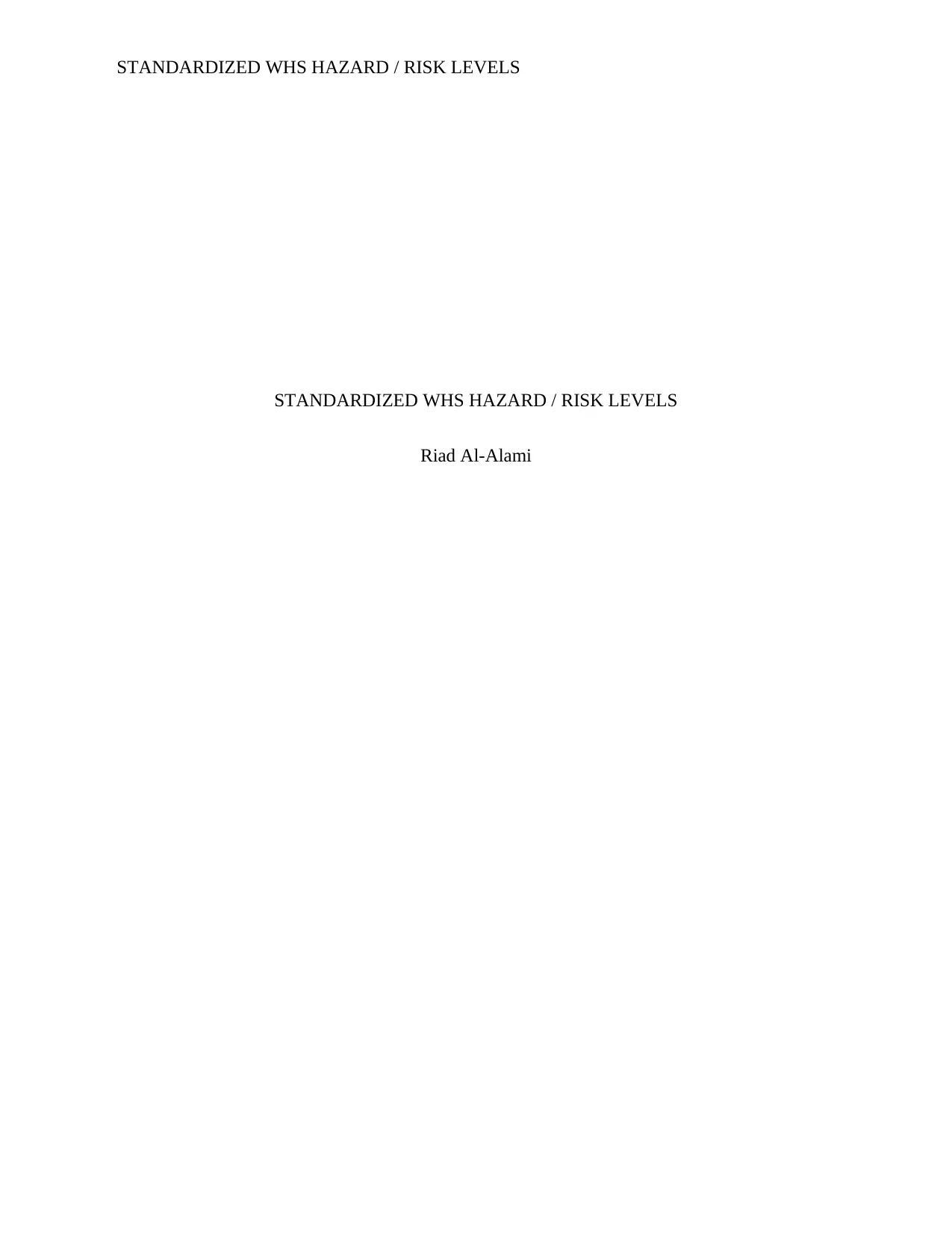
STANDARDIZED WHS HAZARD / RISK LEVELS
STANDARDIZED WHS HAZARD / RISK LEVELS
Riad Al-Alami
STANDARDIZED WHS HAZARD / RISK LEVELS
Riad Al-Alami
Paraphrase This Document
Need a fresh take? Get an instant paraphrase of this document with our AI Paraphraser
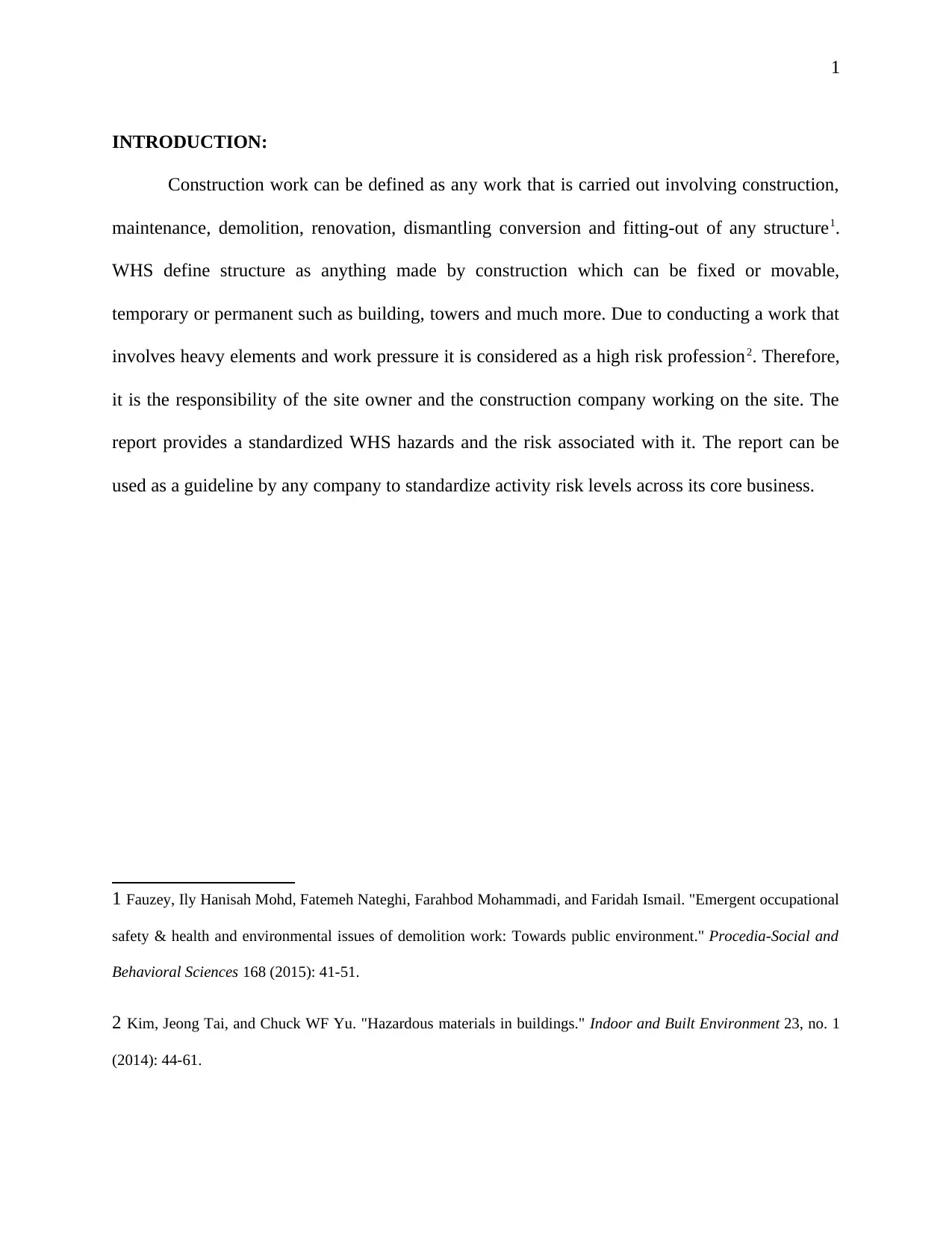
1
INTRODUCTION:
Construction work can be defined as any work that is carried out involving construction,
maintenance, demolition, renovation, dismantling conversion and fitting-out of any structure1.
WHS define structure as anything made by construction which can be fixed or movable,
temporary or permanent such as building, towers and much more. Due to conducting a work that
involves heavy elements and work pressure it is considered as a high risk profession2. Therefore,
it is the responsibility of the site owner and the construction company working on the site. The
report provides a standardized WHS hazards and the risk associated with it. The report can be
used as a guideline by any company to standardize activity risk levels across its core business.
1 Fauzey, Ily Hanisah Mohd, Fatemeh Nateghi, Farahbod Mohammadi, and Faridah Ismail. "Emergent occupational
safety & health and environmental issues of demolition work: Towards public environment." Procedia-Social and
Behavioral Sciences 168 (2015): 41-51.
2 Kim, Jeong Tai, and Chuck WF Yu. "Hazardous materials in buildings." Indoor and Built Environment 23, no. 1
(2014): 44-61.
INTRODUCTION:
Construction work can be defined as any work that is carried out involving construction,
maintenance, demolition, renovation, dismantling conversion and fitting-out of any structure1.
WHS define structure as anything made by construction which can be fixed or movable,
temporary or permanent such as building, towers and much more. Due to conducting a work that
involves heavy elements and work pressure it is considered as a high risk profession2. Therefore,
it is the responsibility of the site owner and the construction company working on the site. The
report provides a standardized WHS hazards and the risk associated with it. The report can be
used as a guideline by any company to standardize activity risk levels across its core business.
1 Fauzey, Ily Hanisah Mohd, Fatemeh Nateghi, Farahbod Mohammadi, and Faridah Ismail. "Emergent occupational
safety & health and environmental issues of demolition work: Towards public environment." Procedia-Social and
Behavioral Sciences 168 (2015): 41-51.
2 Kim, Jeong Tai, and Chuck WF Yu. "Hazardous materials in buildings." Indoor and Built Environment 23, no. 1
(2014): 44-61.
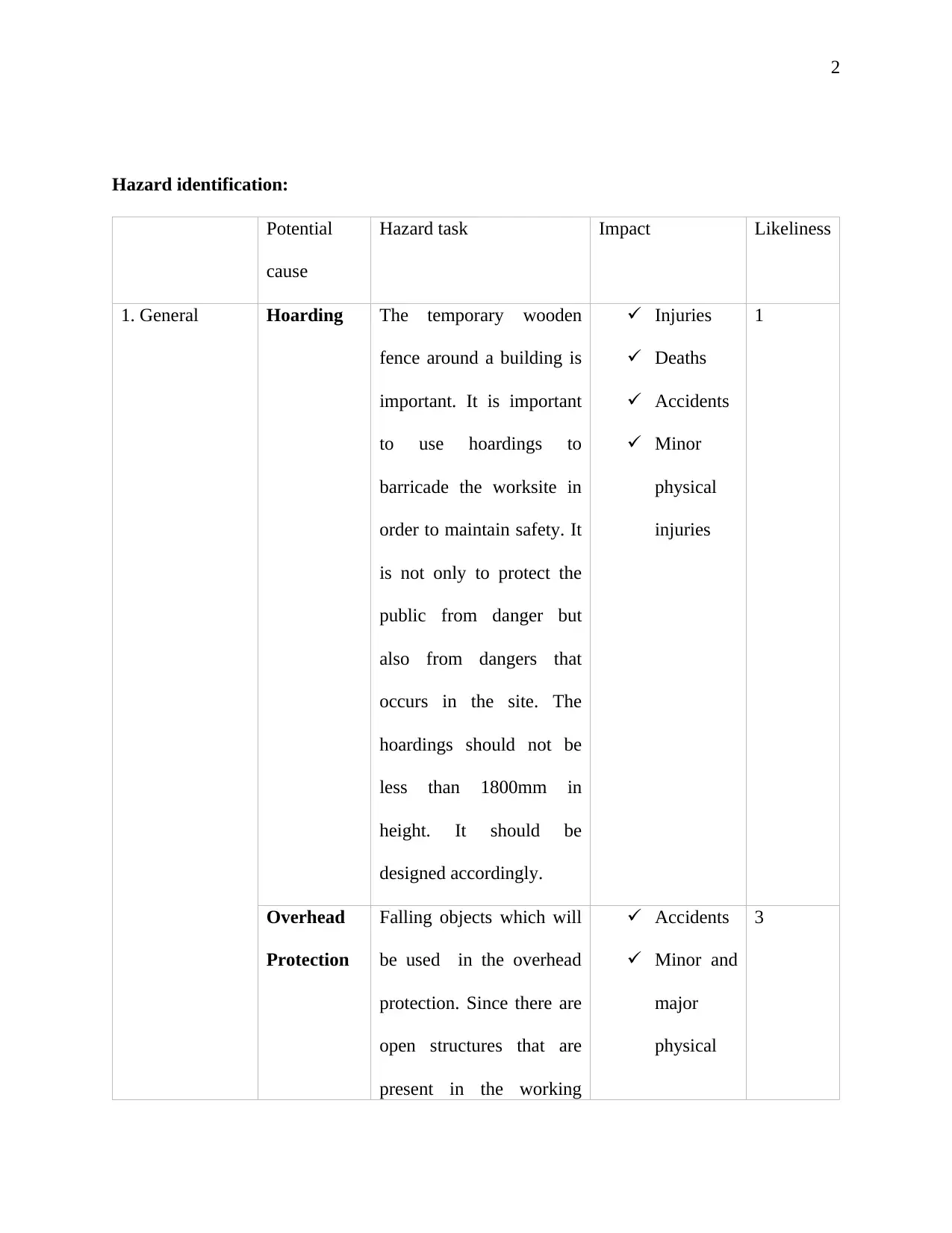
2
Hazard identification:
Potential
cause
Hazard task Impact Likeliness
1. General Hoarding The temporary wooden
fence around a building is
important. It is important
to use hoardings to
barricade the worksite in
order to maintain safety. It
is not only to protect the
public from danger but
also from dangers that
occurs in the site. The
hoardings should not be
less than 1800mm in
height. It should be
designed accordingly.
Injuries
Deaths
Accidents
Minor
physical
injuries
1
Overhead
Protection
Falling objects which will
be used in the overhead
protection. Since there are
open structures that are
present in the working
Accidents
Minor and
major
physical
3
Hazard identification:
Potential
cause
Hazard task Impact Likeliness
1. General Hoarding The temporary wooden
fence around a building is
important. It is important
to use hoardings to
barricade the worksite in
order to maintain safety. It
is not only to protect the
public from danger but
also from dangers that
occurs in the site. The
hoardings should not be
less than 1800mm in
height. It should be
designed accordingly.
Injuries
Deaths
Accidents
Minor
physical
injuries
1
Overhead
Protection
Falling objects which will
be used in the overhead
protection. Since there are
open structures that are
present in the working
Accidents
Minor and
major
physical
3
⊘ This is a preview!⊘
Do you want full access?
Subscribe today to unlock all pages.

Trusted by 1+ million students worldwide
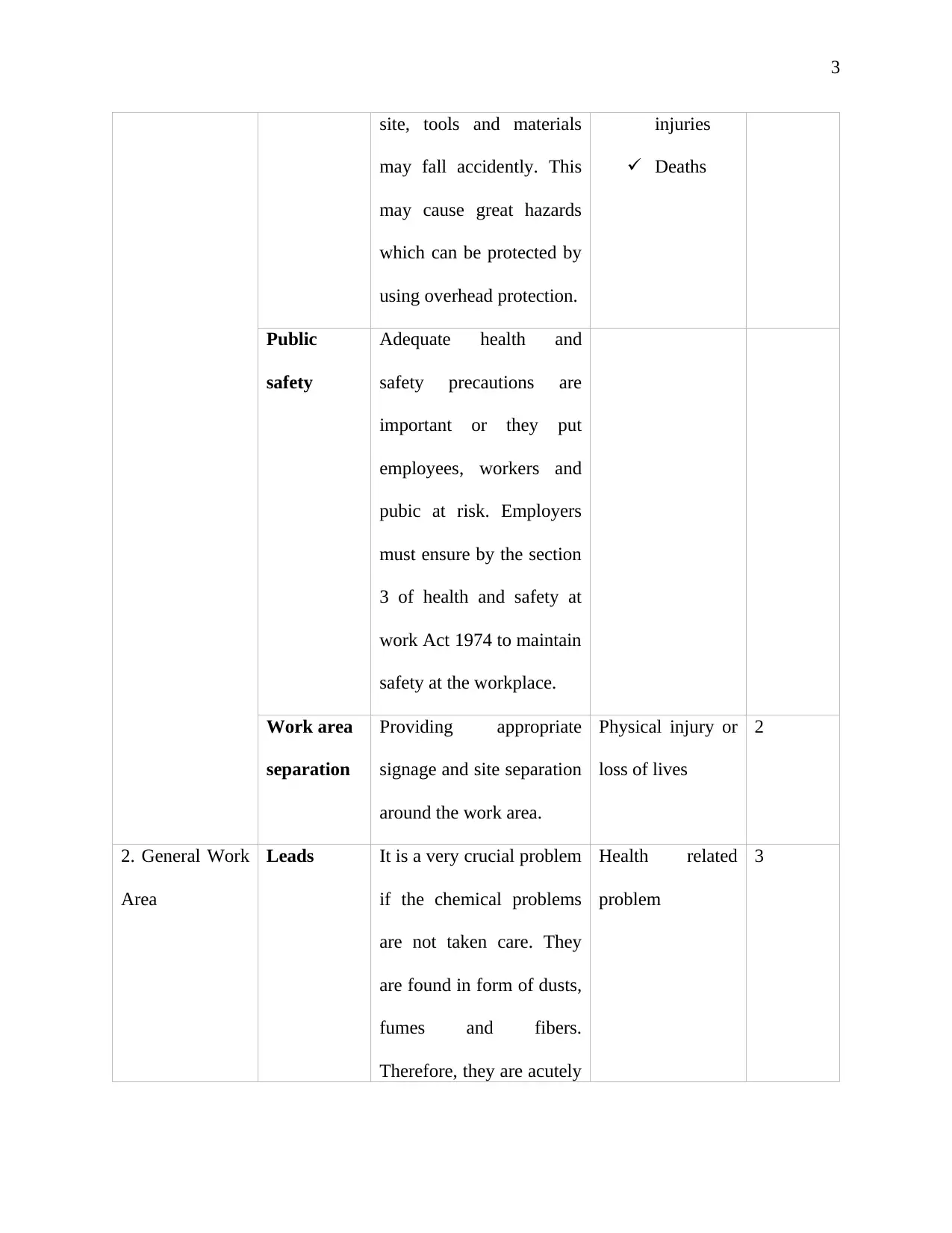
3
site, tools and materials
may fall accidently. This
may cause great hazards
which can be protected by
using overhead protection.
injuries
Deaths
Public
safety
Adequate health and
safety precautions are
important or they put
employees, workers and
pubic at risk. Employers
must ensure by the section
3 of health and safety at
work Act 1974 to maintain
safety at the workplace.
Work area
separation
Providing appropriate
signage and site separation
around the work area.
Physical injury or
loss of lives
2
2. General Work
Area
Leads It is a very crucial problem
if the chemical problems
are not taken care. They
are found in form of dusts,
fumes and fibers.
Therefore, they are acutely
Health related
problem
3
site, tools and materials
may fall accidently. This
may cause great hazards
which can be protected by
using overhead protection.
injuries
Deaths
Public
safety
Adequate health and
safety precautions are
important or they put
employees, workers and
pubic at risk. Employers
must ensure by the section
3 of health and safety at
work Act 1974 to maintain
safety at the workplace.
Work area
separation
Providing appropriate
signage and site separation
around the work area.
Physical injury or
loss of lives
2
2. General Work
Area
Leads It is a very crucial problem
if the chemical problems
are not taken care. They
are found in form of dusts,
fumes and fibers.
Therefore, they are acutely
Health related
problem
3
Paraphrase This Document
Need a fresh take? Get an instant paraphrase of this document with our AI Paraphraser
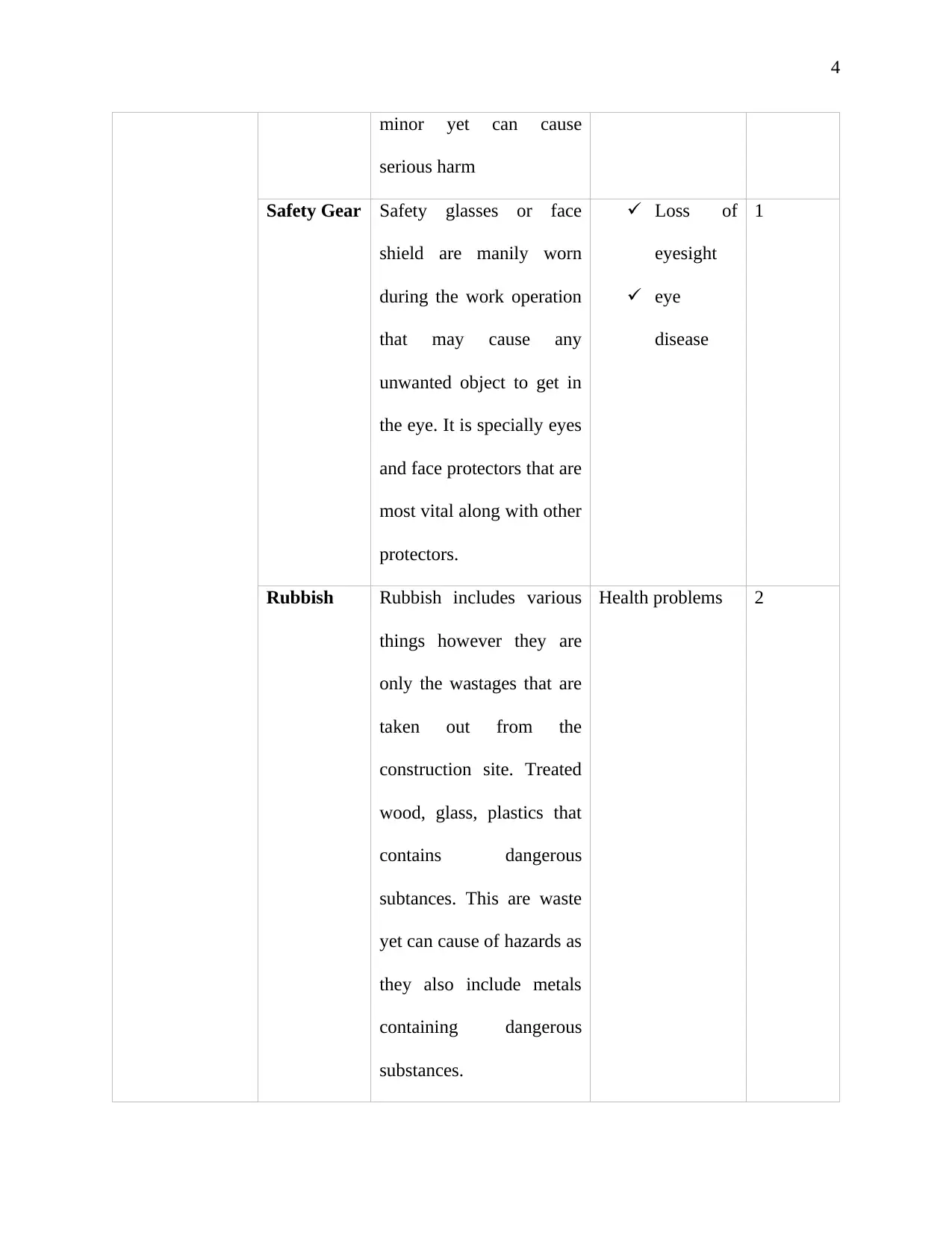
4
minor yet can cause
serious harm
Safety Gear Safety glasses or face
shield are manily worn
during the work operation
that may cause any
unwanted object to get in
the eye. It is specially eyes
and face protectors that are
most vital along with other
protectors.
Loss of
eyesight
eye
disease
1
Rubbish Rubbish includes various
things however they are
only the wastages that are
taken out from the
construction site. Treated
wood, glass, plastics that
contains dangerous
subtances. This are waste
yet can cause of hazards as
they also include metals
containing dangerous
substances.
Health problems 2
minor yet can cause
serious harm
Safety Gear Safety glasses or face
shield are manily worn
during the work operation
that may cause any
unwanted object to get in
the eye. It is specially eyes
and face protectors that are
most vital along with other
protectors.
Loss of
eyesight
eye
disease
1
Rubbish Rubbish includes various
things however they are
only the wastages that are
taken out from the
construction site. Treated
wood, glass, plastics that
contains dangerous
subtances. This are waste
yet can cause of hazards as
they also include metals
containing dangerous
substances.
Health problems 2
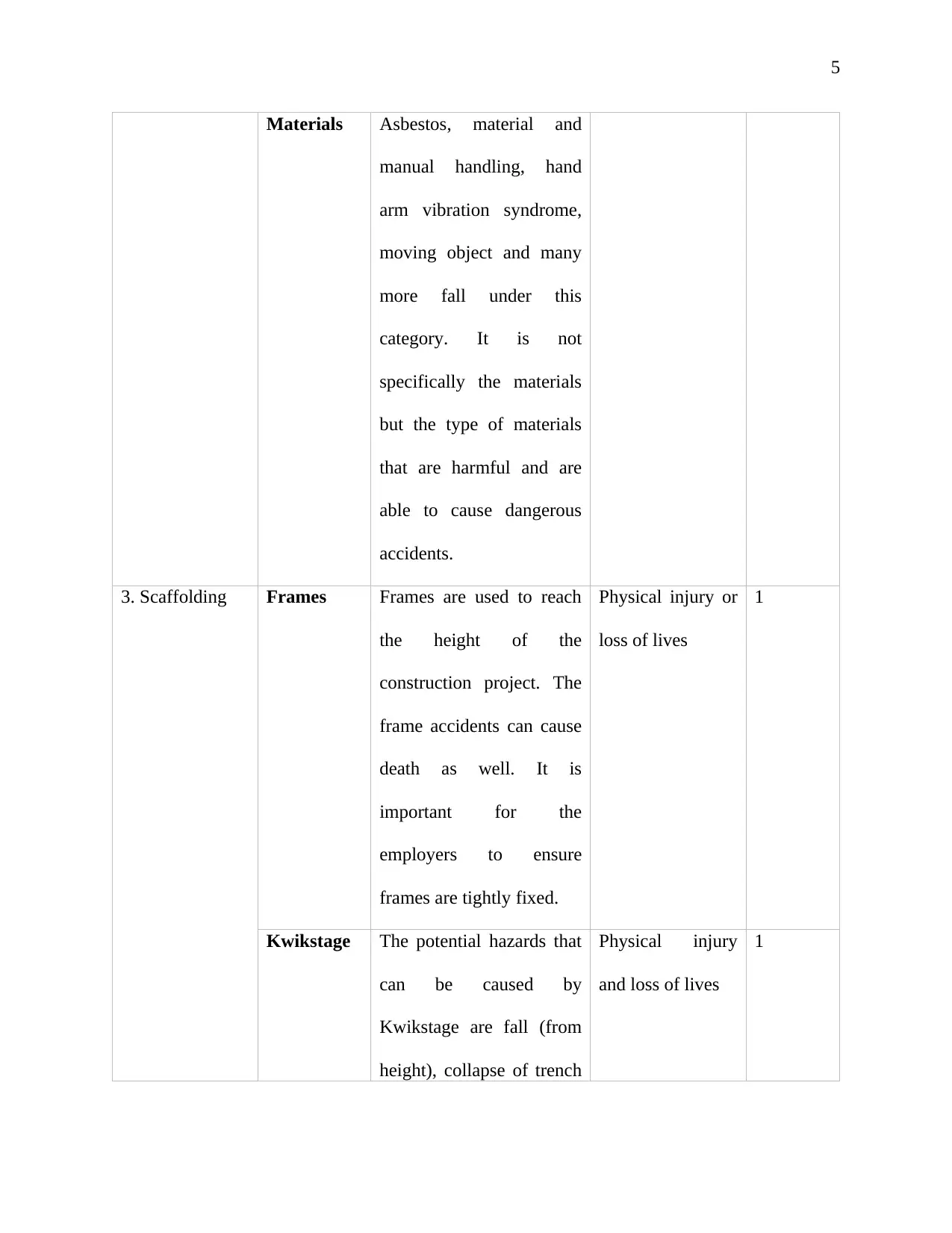
5
Materials Asbestos, material and
manual handling, hand
arm vibration syndrome,
moving object and many
more fall under this
category. It is not
specifically the materials
but the type of materials
that are harmful and are
able to cause dangerous
accidents.
3. Scaffolding Frames Frames are used to reach
the height of the
construction project. The
frame accidents can cause
death as well. It is
important for the
employers to ensure
frames are tightly fixed.
Physical injury or
loss of lives
1
Kwikstage The potential hazards that
can be caused by
Kwikstage are fall (from
height), collapse of trench
Physical injury
and loss of lives
1
Materials Asbestos, material and
manual handling, hand
arm vibration syndrome,
moving object and many
more fall under this
category. It is not
specifically the materials
but the type of materials
that are harmful and are
able to cause dangerous
accidents.
3. Scaffolding Frames Frames are used to reach
the height of the
construction project. The
frame accidents can cause
death as well. It is
important for the
employers to ensure
frames are tightly fixed.
Physical injury or
loss of lives
1
Kwikstage The potential hazards that
can be caused by
Kwikstage are fall (from
height), collapse of trench
Physical injury
and loss of lives
1
⊘ This is a preview!⊘
Do you want full access?
Subscribe today to unlock all pages.

Trusted by 1+ million students worldwide
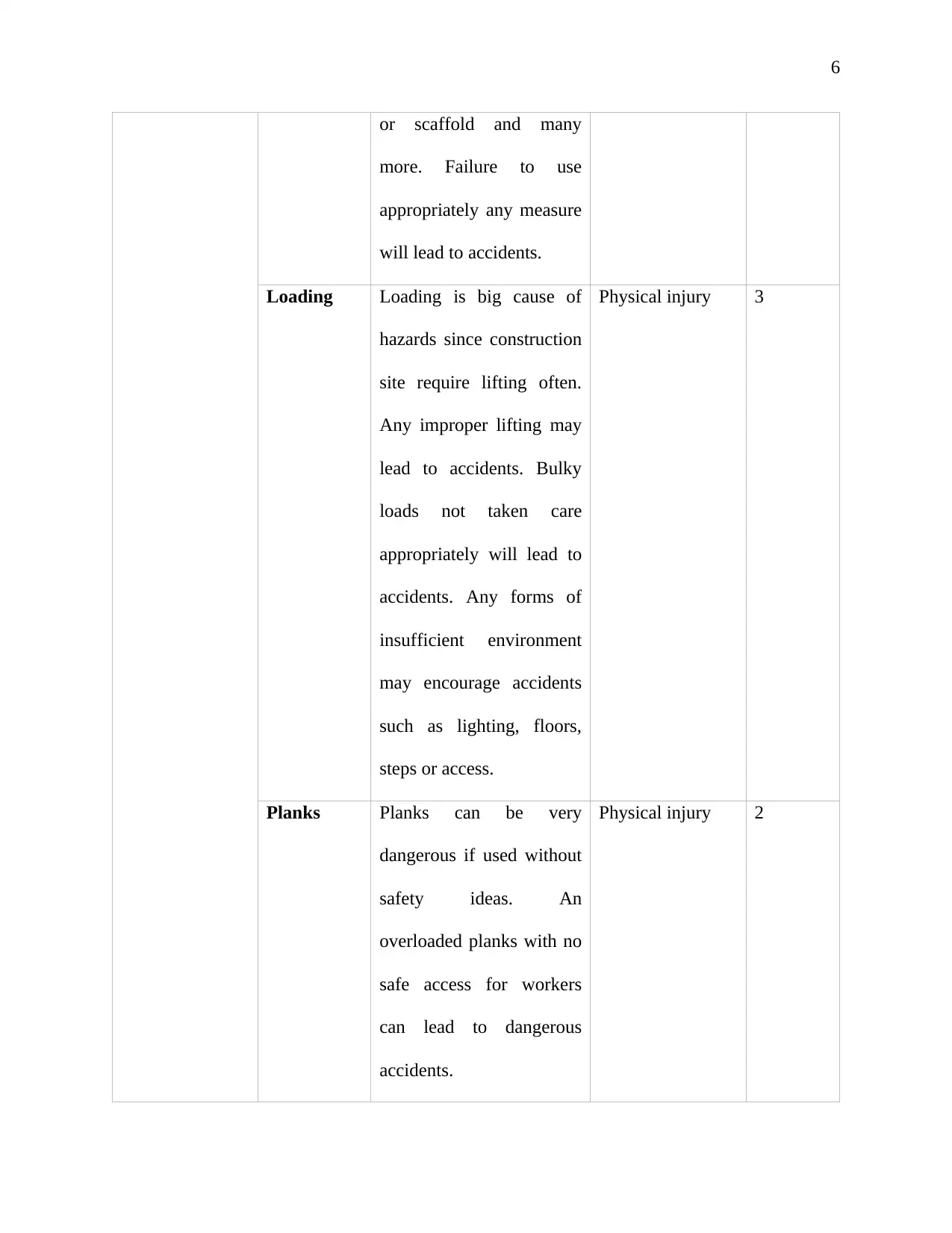
6
or scaffold and many
more. Failure to use
appropriately any measure
will lead to accidents.
Loading Loading is big cause of
hazards since construction
site require lifting often.
Any improper lifting may
lead to accidents. Bulky
loads not taken care
appropriately will lead to
accidents. Any forms of
insufficient environment
may encourage accidents
such as lighting, floors,
steps or access.
Physical injury 3
Planks Planks can be very
dangerous if used without
safety ideas. An
overloaded planks with no
safe access for workers
can lead to dangerous
accidents.
Physical injury 2
or scaffold and many
more. Failure to use
appropriately any measure
will lead to accidents.
Loading Loading is big cause of
hazards since construction
site require lifting often.
Any improper lifting may
lead to accidents. Bulky
loads not taken care
appropriately will lead to
accidents. Any forms of
insufficient environment
may encourage accidents
such as lighting, floors,
steps or access.
Physical injury 3
Planks Planks can be very
dangerous if used without
safety ideas. An
overloaded planks with no
safe access for workers
can lead to dangerous
accidents.
Physical injury 2
Paraphrase This Document
Need a fresh take? Get an instant paraphrase of this document with our AI Paraphraser
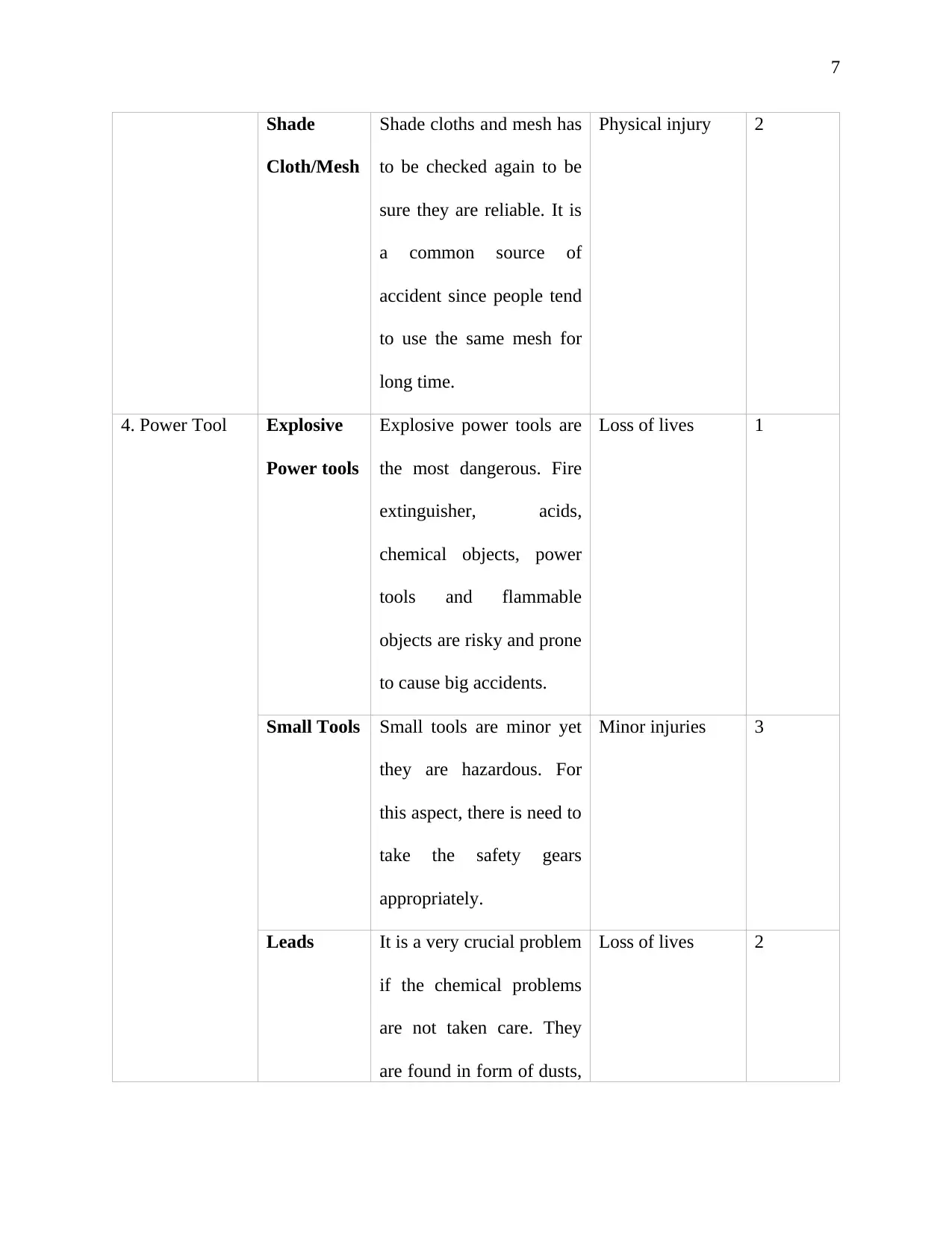
7
Shade
Cloth/Mesh
Shade cloths and mesh has
to be checked again to be
sure they are reliable. It is
a common source of
accident since people tend
to use the same mesh for
long time.
Physical injury 2
4. Power Tool Explosive
Power tools
Explosive power tools are
the most dangerous. Fire
extinguisher, acids,
chemical objects, power
tools and flammable
objects are risky and prone
to cause big accidents.
Loss of lives 1
Small Tools Small tools are minor yet
they are hazardous. For
this aspect, there is need to
take the safety gears
appropriately.
Minor injuries 3
Leads It is a very crucial problem
if the chemical problems
are not taken care. They
are found in form of dusts,
Loss of lives 2
Shade
Cloth/Mesh
Shade cloths and mesh has
to be checked again to be
sure they are reliable. It is
a common source of
accident since people tend
to use the same mesh for
long time.
Physical injury 2
4. Power Tool Explosive
Power tools
Explosive power tools are
the most dangerous. Fire
extinguisher, acids,
chemical objects, power
tools and flammable
objects are risky and prone
to cause big accidents.
Loss of lives 1
Small Tools Small tools are minor yet
they are hazardous. For
this aspect, there is need to
take the safety gears
appropriately.
Minor injuries 3
Leads It is a very crucial problem
if the chemical problems
are not taken care. They
are found in form of dusts,
Loss of lives 2
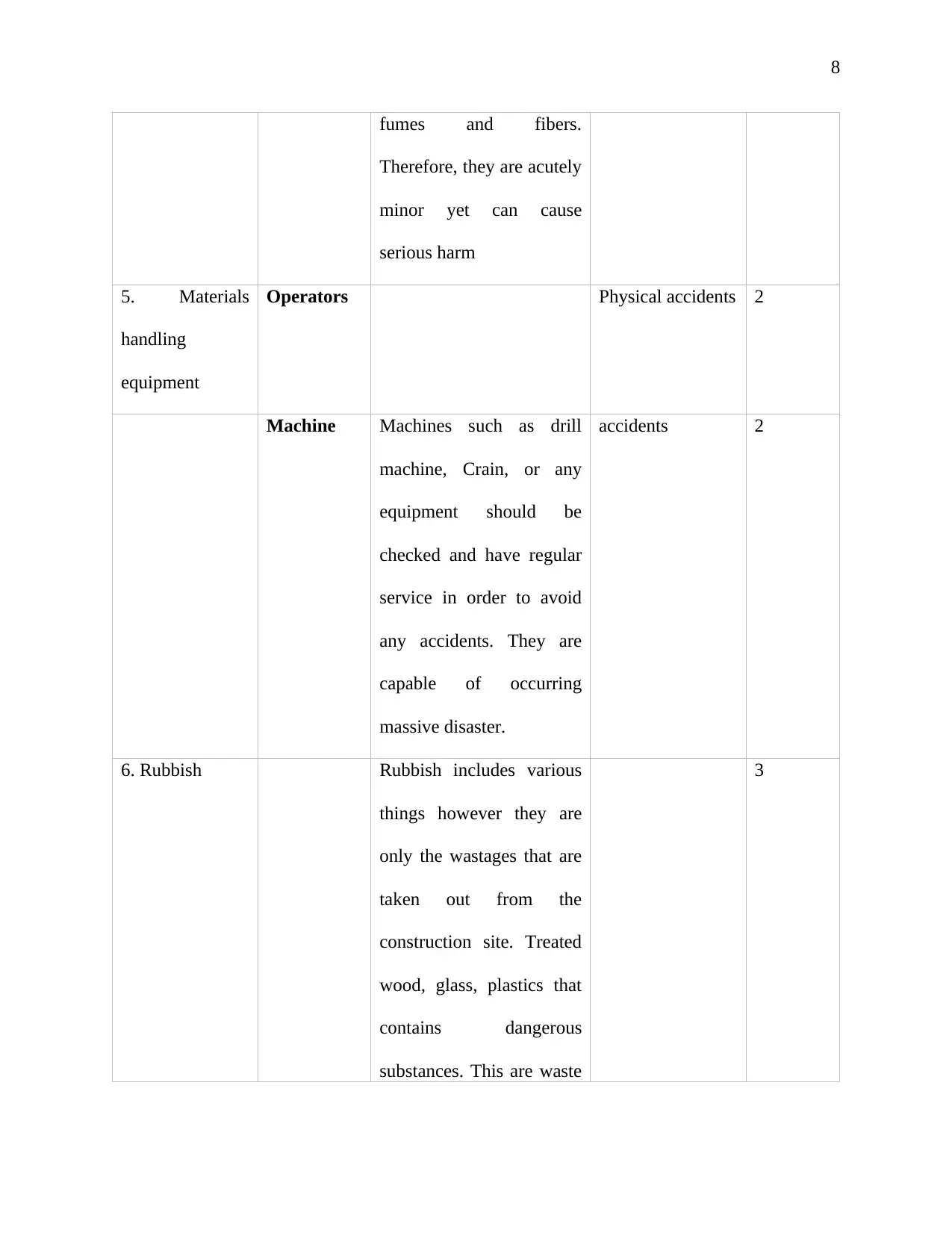
8
fumes and fibers.
Therefore, they are acutely
minor yet can cause
serious harm
5. Materials
handling
equipment
Operators Physical accidents 2
Machine Machines such as drill
machine, Crain, or any
equipment should be
checked and have regular
service in order to avoid
any accidents. They are
capable of occurring
massive disaster.
accidents 2
6. Rubbish Rubbish includes various
things however they are
only the wastages that are
taken out from the
construction site. Treated
wood, glass, plastics that
contains dangerous
substances. This are waste
3
fumes and fibers.
Therefore, they are acutely
minor yet can cause
serious harm
5. Materials
handling
equipment
Operators Physical accidents 2
Machine Machines such as drill
machine, Crain, or any
equipment should be
checked and have regular
service in order to avoid
any accidents. They are
capable of occurring
massive disaster.
accidents 2
6. Rubbish Rubbish includes various
things however they are
only the wastages that are
taken out from the
construction site. Treated
wood, glass, plastics that
contains dangerous
substances. This are waste
3
⊘ This is a preview!⊘
Do you want full access?
Subscribe today to unlock all pages.

Trusted by 1+ million students worldwide
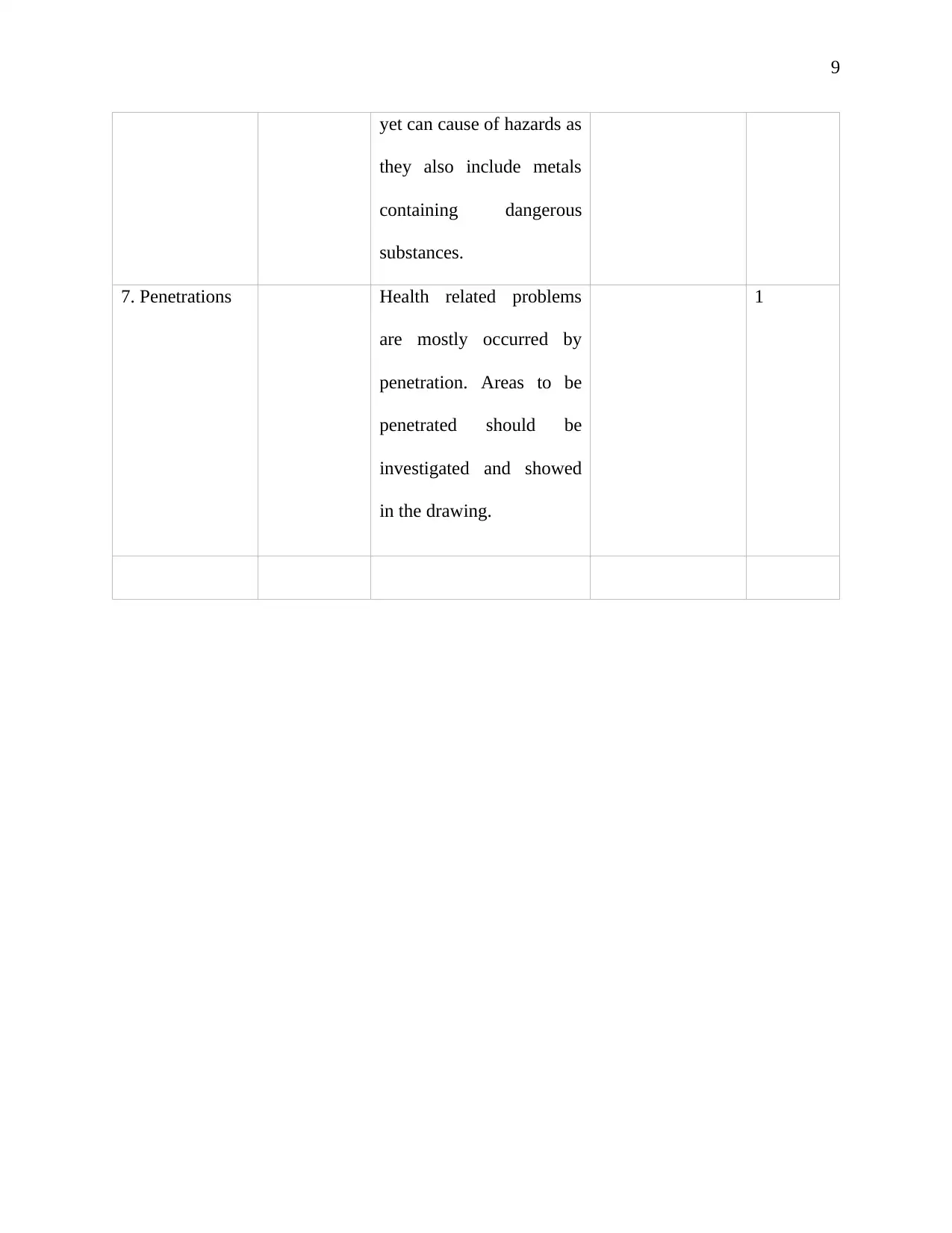
9
yet can cause of hazards as
they also include metals
containing dangerous
substances.
7. Penetrations Health related problems
are mostly occurred by
penetration. Areas to be
penetrated should be
investigated and showed
in the drawing.
1
yet can cause of hazards as
they also include metals
containing dangerous
substances.
7. Penetrations Health related problems
are mostly occurred by
penetration. Areas to be
penetrated should be
investigated and showed
in the drawing.
1
Paraphrase This Document
Need a fresh take? Get an instant paraphrase of this document with our AI Paraphraser
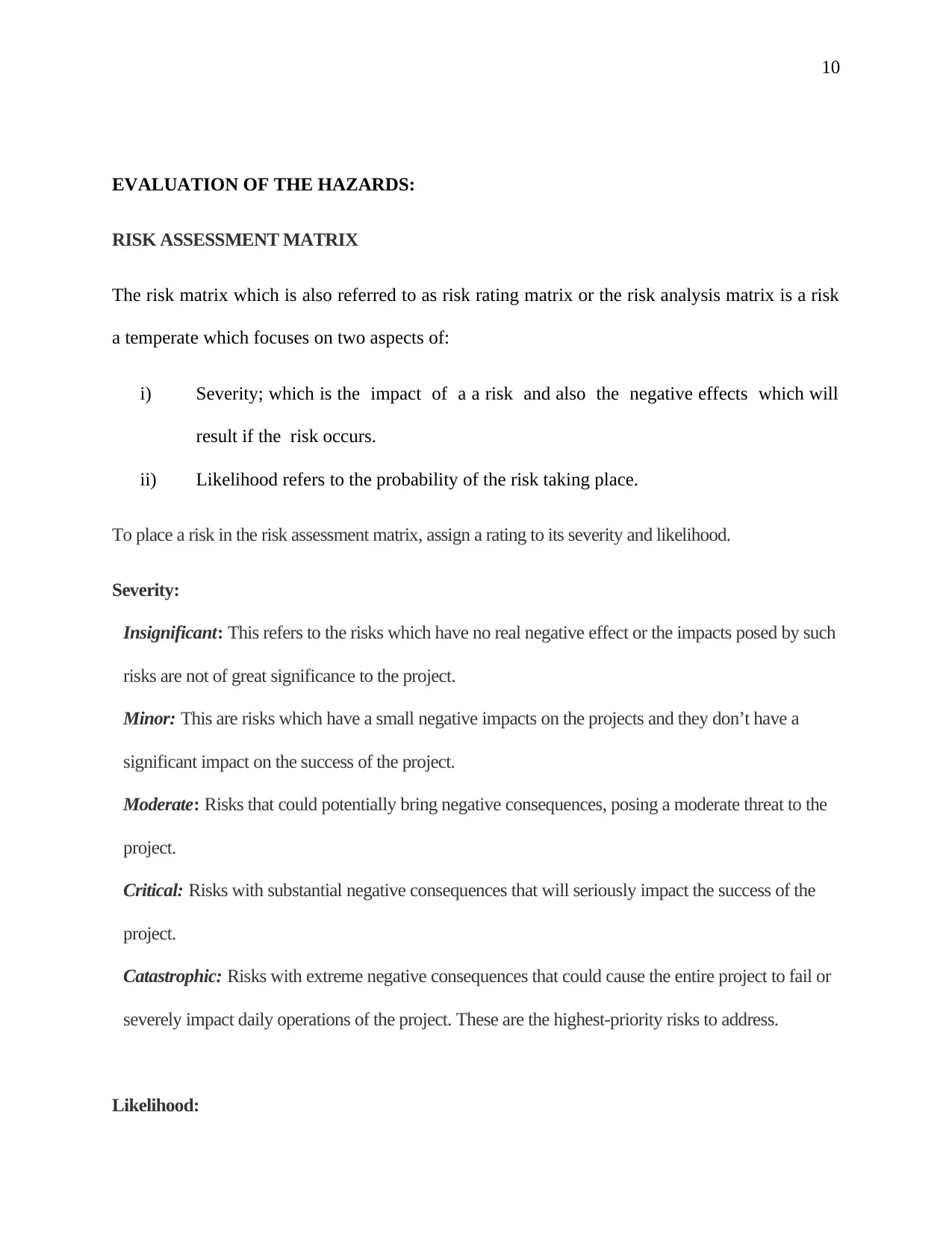
10
EVALUATION OF THE HAZARDS:
RISK ASSESSMENT MATRIX
The risk matrix which is also referred to as risk rating matrix or the risk analysis matrix is a risk
a temperate which focuses on two aspects of:
i) Severity; which is the impact of a a risk and also the negative effects which will
result if the risk occurs.
ii) Likelihood refers to the probability of the risk taking place.
To place a risk in the risk assessment matrix, assign a rating to its severity and likelihood.
Severity:
Insignificant: This refers to the risks which have no real negative effect or the impacts posed by such
risks are not of great significance to the project.
Minor: This are risks which have a small negative impacts on the projects and they don’t have a
significant impact on the success of the project.
Moderate: Risks that could potentially bring negative consequences, posing a moderate threat to the
project.
Critical: Risks with substantial negative consequences that will seriously impact the success of the
project.
Catastrophic: Risks with extreme negative consequences that could cause the entire project to fail or
severely impact daily operations of the project. These are the highest-priority risks to address.
Likelihood:
EVALUATION OF THE HAZARDS:
RISK ASSESSMENT MATRIX
The risk matrix which is also referred to as risk rating matrix or the risk analysis matrix is a risk
a temperate which focuses on two aspects of:
i) Severity; which is the impact of a a risk and also the negative effects which will
result if the risk occurs.
ii) Likelihood refers to the probability of the risk taking place.
To place a risk in the risk assessment matrix, assign a rating to its severity and likelihood.
Severity:
Insignificant: This refers to the risks which have no real negative effect or the impacts posed by such
risks are not of great significance to the project.
Minor: This are risks which have a small negative impacts on the projects and they don’t have a
significant impact on the success of the project.
Moderate: Risks that could potentially bring negative consequences, posing a moderate threat to the
project.
Critical: Risks with substantial negative consequences that will seriously impact the success of the
project.
Catastrophic: Risks with extreme negative consequences that could cause the entire project to fail or
severely impact daily operations of the project. These are the highest-priority risks to address.
Likelihood:
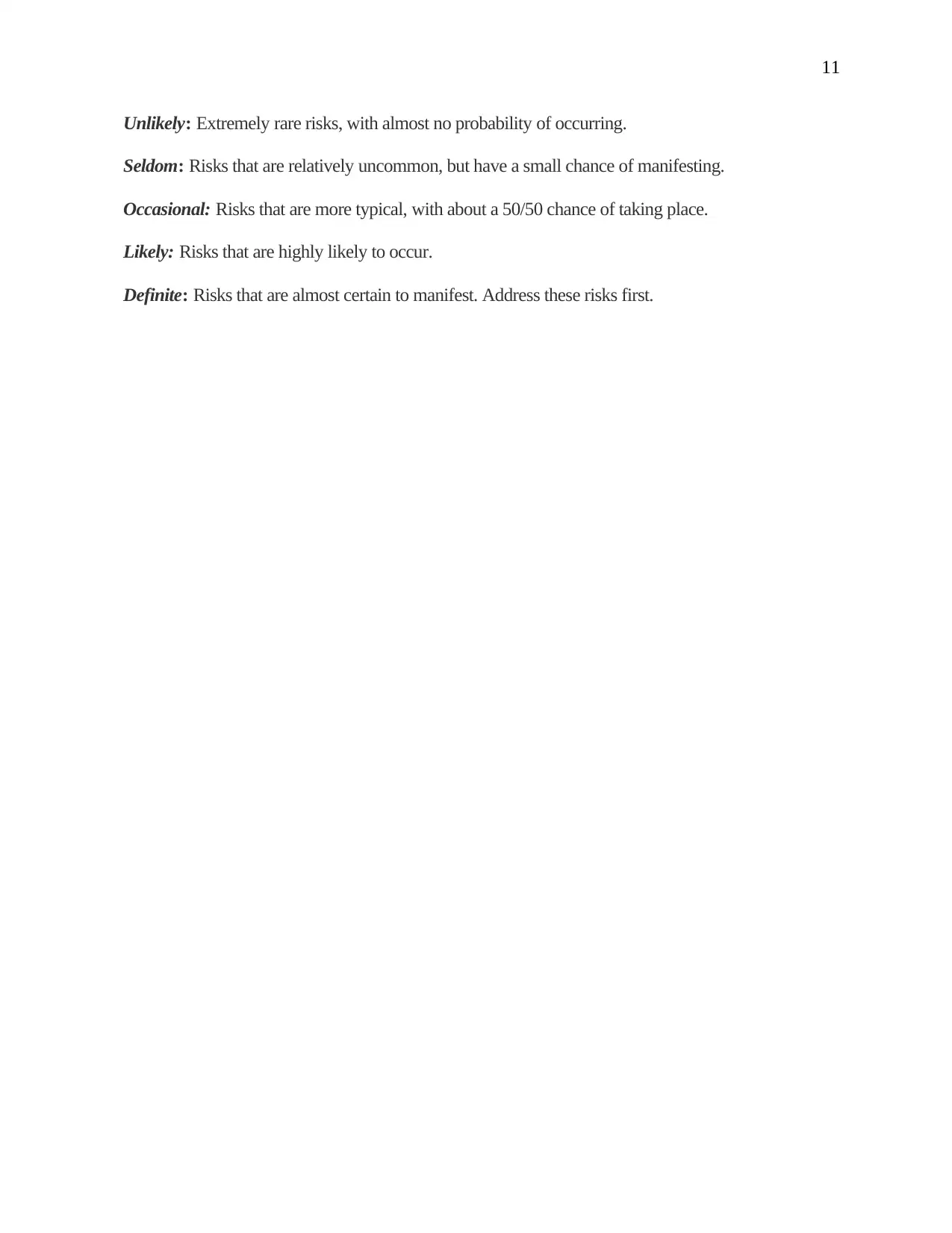
11
Unlikely: Extremely rare risks, with almost no probability of occurring.
Seldom: Risks that are relatively uncommon, but have a small chance of manifesting.
Occasional: Risks that are more typical, with about a 50/50 chance of taking place.
Likely: Risks that are highly likely to occur.
Definite: Risks that are almost certain to manifest. Address these risks first.
Unlikely: Extremely rare risks, with almost no probability of occurring.
Seldom: Risks that are relatively uncommon, but have a small chance of manifesting.
Occasional: Risks that are more typical, with about a 50/50 chance of taking place.
Likely: Risks that are highly likely to occur.
Definite: Risks that are almost certain to manifest. Address these risks first.
⊘ This is a preview!⊘
Do you want full access?
Subscribe today to unlock all pages.

Trusted by 1+ million students worldwide
1 out of 24
Related Documents
Your All-in-One AI-Powered Toolkit for Academic Success.
+13062052269
info@desklib.com
Available 24*7 on WhatsApp / Email
![[object Object]](/_next/static/media/star-bottom.7253800d.svg)
Unlock your academic potential
Copyright © 2020–2025 A2Z Services. All Rights Reserved. Developed and managed by ZUCOL.




